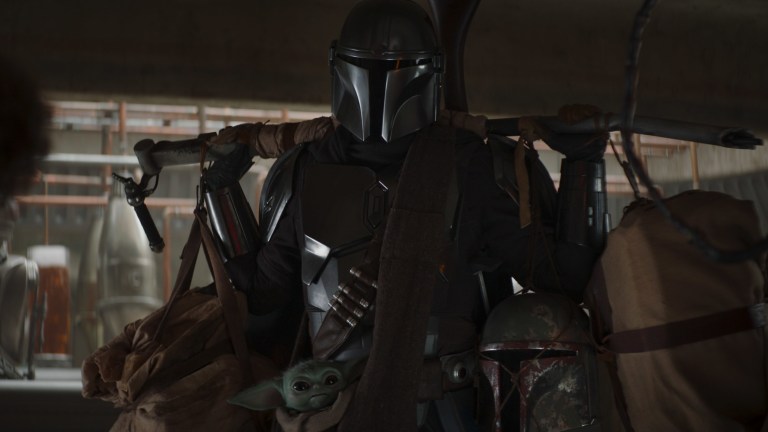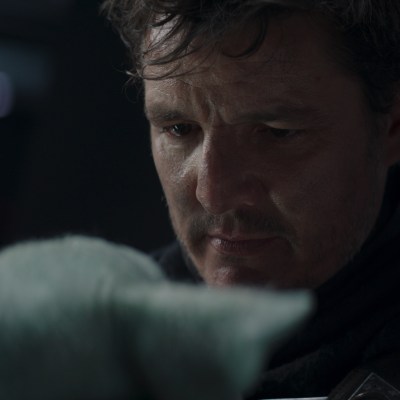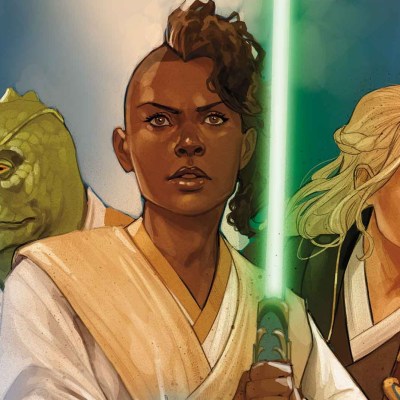How The Mandalorian Gave Fans a Different Kind of Star Wars Story
The Mandalorian isn't your typical Star Wars story. It embraces the power of a simple story like no other live-action entry before it.

This Star Wars: The Mandalorian article contains spoilers.
Technically, Disney+’s The Mandalorian is part of the biggest franchise on earth. But it doesn’t always feel that way.
True, it’s a Star Wars property, and it rarely lets you forget that fact. The show is rife with references to the films and animated series that have come before it and it enjoys padding out existing lore in ways that only the most hardcore of fans will care about—or possibly even notice. (Did you remember there was a krayt dragon skeleton in A New Hope? Be honest.)
The Mandalorian isn’t a story that requires a tremendous amount of Star Wars knowledge to follow or enjoy. And that’s because its central tale is one that follows rules and patterns we’ve all seen before. A mix of tropes from classic spaghetti westerns and samurai adventures, the show offers a broad look at life on the edge of the galaxy that exists well beyond the world of Jedi Knights, Sith warriors, and space princesses. And its tale of a lone bounty hunter and the supercute Force-wielding toddler he is charged with protecting is proof positive that there is space for every kind of story in this franchise. (As well as every kind of fan.)
Stream your Star Wars favorites right here!
In a universe that has become increasingly dense and self-contained, The Mandalorian still manages to feel like a breath of fresh air. Sure, its second season finale includes a surprise appearance by Luke Skywalker, because no property in this universe can apparently escape that family and their seemingly never-ending daddy issues, but the Disney+ series doesn’t seem concerned with him as anything other than a vehicle to further the story of Din Djarin, a good man who is trying to do right – by his faith, by his people, by the tiny creature whose life has suddenly become intertwined with his own.
Though the eponymous Mandalorian has run across a bevy of characters that have made longtime fans shriek with delight (Boba Fett, Bo-Katan, Ahsoka Tano, Luke himself), and the series ties in rather neatly with other franchise properties like The Clone Wars and Rebels, it still understands that its greatest strengths stem from its smaller stakes, more realistic worldbuilding, and the emotional connection between two vastly different creatures.
The Mandalorian isn’t an epic adventure, a space opera about the future of the galaxy as we understand it, or a tragedy about a single family’s apparent inability to keep from making the same mistakes from one generation to the next. It’s a story that’s deliberately limited in its scope and modest in its ambitions and, at the end of the day, the show itself is all the stronger for these choices.
In comparison to other Star Wars properties, The Mandalorian’s story is almost painfully straightforward, if perhaps a little bit darker in places than we’re maybe used to in this universe thus far. Set in the galaxy’s Outer Rim following the fall of the Galactic Empire, it generally deals with characters – including its own lead – who are not terribly complicated people. Their lives are simpler, rougher, and more focused on the everyday challenges of living than the Jedi and characters like them that populate the films.
Even the Mandalorian himself is simultaneously an avatar and a real person, and we get to know him as much through his struggles as his successes. He is, after all, the most reluctant of saviors. Yet, as many lone warriors before him, he is also a man with a code, and he holds tight to it, even in the lawless outskirts of the galaxy.
Occasionally Mando will have to rescue someone or must join forces with an uneasy partner in order to kill a monster or pull off a heist. But no matter how that particular adventure goes, by the end of the hour, he’s back on his path and moving toward his next goal. The show doesn’t really have “arcs” so much as stories that occasionally take place over an episode or two—see the transport of the Frog Lady back to her partner that begins in “The Passenger” and ends in the subsequent installment—and its most dramatic set pieces generally rely on Mando fighting something, ranging from a furious mudhorn to ravenous, gross ice spiders.
In the world of genre storytelling, serialized stories with twisty plots and puzzle-box mysteries are all the rage right now. Just look at shows like Westworld, a drama that—as much as I love it—spends much of its time tying itself into complex narrative knots it doesn’t really know how to get out of. So, a show like The Mandalorian, with its linear narrative, clear-eyed storytelling, and refreshingly basic plots suddenly feels like a revelation.
And maybe it is.
The fact is, there’s still real value in a simple story about a man doing his best, no matter what circumstances he finds himself in. Maybe we’ve forgotten that fact in a television landscape that’s conditioned us to always be looking for a trick or a surprise reveal, but The Mandalorian’s largely straightforward narrative proves that it doesn’t have to be that way. And the show is as satisfying as any series that requires complex fan theories to enjoy or in-depth explainers to fully understand.
The explainers are nice, don’t get me wrong, but in all honesty, the show is doing just fine introducing existing canon characters like Ahsoka to new audiences on its own. You don’t need to have watched Rebels to enjoy her presence here, but if you have, the satisfaction is all the greater. Truly, we don’t give The Mandalorian enough credit for the delicate balance it strikes in the age old struggle between storytelling and fanservice. It’s a difficult thing, and the show walks a fine line both carefully and well.
Even the appearance of Luke, probably the ultimate moment in Star Wars pandering, exists not for its own sake so much as it does to advance the series’ main relationship – that between Din and young Grogu. (If you didn’t get a little emotional watching them say goodbye to one another, then you have no heart, I’m sorry.)
There’s little of the narrative baggage that usually comes along with a Skywalker arriving on the scene here – it doesn’t appear that anyone else even knows who he is beyond the fact that he is a Jedi – and though he’s meant to teach Grogu the ways of the Force, there’s no real indication we’ll see Luke again. After all, he has to start off down the path that leads him to The Last Jedi, and Grogu will undoubtedly return to his Mandalorian’s side at some point in the not too distant future. Disney knows where its money is, after all. And it’s not in Pedro Pascal merch, much as we all love him.
The Mandalorian’s first season occasionally drew criticism for what naysayers deemed a “flimsy” or “barely there” plot, but this underestimates the power inherent in the series’ simple framework. Not only is it an emotional balm for those of us who are, quite frankly, tired of hour-long installments that require a significant amount of work to understand, it actually serves an important narrative purpose. The slower pace and simpler story allow us to get to know Mando and his culture, and gives the Star Wars universe a chance to take a minute and breathe.
The Skywalker films are so full of big, potentially galaxy ending stakes and consequences that we as viewers get little time to simply take the universe in on its own terms – let alone get to know the people that inhabit it. We’re usually too busy worrying about how it all ties back to the family at the story’s center or the Jedi they serve.
The Mandalorian has shown us what the Star Wars world outside of all the Skywalker drama looks like – even though it briefly includes one of them – and it lets us take our time to gawk at its sketchy bars, enjoy its colorful characters, and travel through run-down desolate towns at a slower pace. It’s allowed us to invest in the emotional connection between a lonely man and a lost creature who may be the last of its kind. And quaint though all that might seem, it’s certainly turned out to be a journey worth taking.



